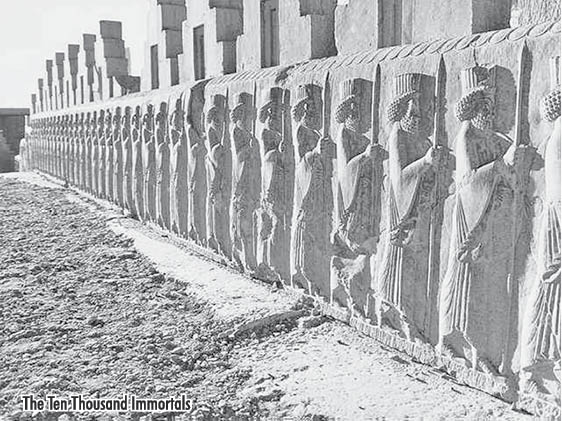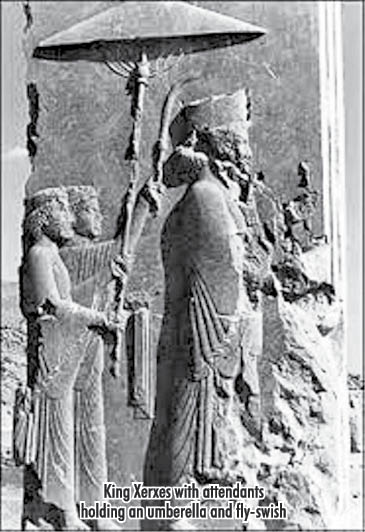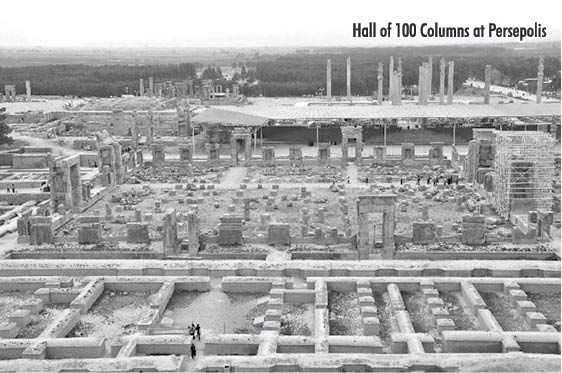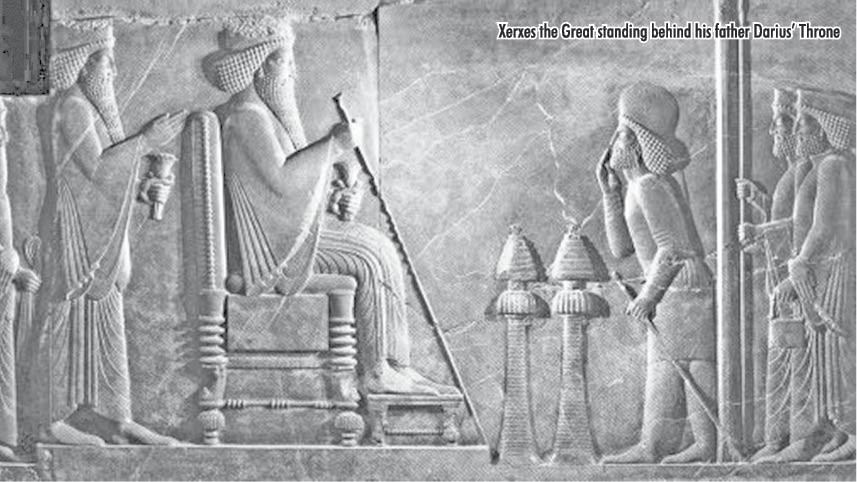.
Xerxes The Great .
Xerxes is the Greek version of the Persian name Khshayarsha. He was the son of Darius the Great and Atossa, the daughter of Cyrus the Great. Xerxes was designated heir apparent by his father in preference to his elder brother, Artabazanes. A bas-relief on the southern portico of a courtyard in the treasury of Persepolis depicts him as the heir apparent, standing behind his father, who is seated on the throne.
When his father died, in 486 BC, Xerxes was about 35 years old and had already governed Babylonia for 12 years. One of his first concerns upon his accession was to quell the unrest in Egypt, where a usurper had been governing for two years. However, Xerxes is best known for his massive invasion of Greece from across the Hellespont (480 BC), a strategic campaign marked by the battles of Thermopylae, Salamis, and Plataea.
 Assembling The World’s Largest Army:
Assembling The World’s Largest Army:
It took Xerxes four years to plan and prepare for his massive invasion of Greece. From every corner of the Persian Empire, Xerxes collected immense quantities of food, money, and weapons, which he amassed for the impending conquest. Xerxes’ army was the biggest that had ever been assembled in the ancient world, numbering at least several hundred thousand troops. The army’s strongest regiment was an elite corps of ten thousand handpicked warriors known as the Immortals. This army began marching toward Greece in the spring of 480 B.C. It took a full week for the entire force to pass by any given point along the line of the march. As the thirsty army passed through the countryside, springs, wells and small rivers along its route were frequently drunk dry.
Xerxes ordered a fleet of a thousand warships to sail along the coast of the Aegean Sea, following his army and carrying provisions for the long march to Greece. Xerxes and his army crossed the straits of the Dardanelles, at the mouth of the Black Sea into the kingdom of Thrace. The Thracians offered no resistance to the overwhelming Persian army. As the army marched along the northern coast of the Aegean Sea into the kingdom of Macedonia, one city after another surrendered without a fight.
In each submissive city, a great feast was ordered to be prepared especially for Xerxes and the 10,000 Immortals. These banquets were catered with the finest foods available, and were set with the costliest golden and silver tableware that could be offered up by the local nobility. Each morning, the Persians moved on to occupy a new city, taking with them everything of value that had been provided the night before.
The Ten Thousand Immortals:
The Immortals was the name given by Herodotus to an elite heavily-armed infantry unit of 10,000 soldiers in the great army of the Achaemenid Empire. This force performed the dual roles of both Imperial Guard and Standing Army. The force consisted mainly of Persians, but also included Medes and Elamites.
This army was kept constantly at a strength of exactly 10,000 men. This armed unit’s name stemmed from the custom that every killed, seriously wounded, or sick member was immediately replaced with a new one, maintaining the corps as a cohesive entity with a constant strength of ten thousand.
 Battle Of Thermopylae:
Battle Of Thermopylae:
Passing through northern Greece, Xerxes met no opposition until he reached the rocky seashore of Thermopylae, about ninety miles from Athens. There, a small army of Greek soldiers had reinforced an ancient stone wall across the road, where it followed a narrow beach between steep cliffs and the sea. The Greek soldiers waiting behind the wall were emergency troops that had been hastily assembled from Greek city-states to the south. However, a Greek traitor informed the Persians about a hidden mountain pass that could be used by the Persians to completely bypass the Greek defenses.
When the Greeks realized that they were being surrounded, most of them retreated, leaving behind a rear guard of three hundred men from the Greek city-state of Sparta. This episode has been grossly exaggerated, distorted and reduced to a tragic mockery in the Hollywood movie ‘The 300’.
Xerxes quickly disposed this small force of Spartans at Thermopylae. After that, no obstacle stood between Xerxes and the city of Athens. When the Persian army moved into Athens, the civilian population of the city had fled to the offshore island of Salamis. A few Greek holdouts that tried to defend the Acropolis were killed by Xerxes’s troops. The stated goal of the Persian invasion was fully accomplished. Xerxes had avenged his father’s defeat by the Athenians at Marathon.
 Building And Maintaining Infrastructure:
Building And Maintaining Infrastructure:
Xerxes returned to Persia and completed the many construction projects left unfinished by his father at Susa and Persepolis. He built the Gate of all Nations and the Hall of a Hundred Columns at Persepolis, which are the largest and most imposing structures of the palace. He completed the Apadana, the Palace of Darius and the Treasury all started by Darius as well as building his own palace which was twice the size of his father’s. His taste in architecture was similar to that of Darius, though on an even more gigantic scale. He also maintained the Royal Road built by his father and completed the Susa Gate and built a palace at Susa.
 Huge Empire:
Huge Empire:
At the height of its power, the empire encompassed approximately 8 million square kilometers spanning three continents: Asia, Africa and Europe. The empire included the modern territories of Iran, Turkey, parts of Central Asia, Pakistan, Thrace and Macedonia, much of the Black Sea coastal regions, Afghanistan, Iraq, northern Saudi Arabia, Jordan, Israel, Lebanon, Syria, and all significant population centers of ancient Egypt as far west as Libya. The empire had a centralized, bureaucratic administration under the Emperor and a large professional army and civil services, inspiring similar developments in later empires.
In 480 BCE, it is estimated that 50 million people lived in the Achaemenid Empire or about 44% of the world’s population at the time, making it the largest ever empire by population in percentage terms.
Upholding Zoroastrian Values:
A stone tablet with one of the most famous inscriptions of Xerxes the Great is preserved to this date in the Museum at Persepolis. The inscription states:
“A great God is Ahura Mazda, who created excellent work which is seen, who created happiness for man, who bestowed wisdom and activity upon Xerxes the King.
Saith Xerxis the King, “By the favour of Ahura Mazda, I am of such a sort that I am a friend to the right. I am not a friend to the wrong. It is not my desire that the weak man should have wrong done to him by the mighty, nor is that my desire that the mighty man should have wrong done to him by the weak.
What is Right is my desire. I am not a friend to the man who is a lie follower.
I am not hot tempered. What things develop in my anger, I hold firmly under control by my thinking power. I am firmly ruling over my own impulses.
The man who co-operates, him according to his co-operative action, him thus do I reward. Who does harm, him according to the damage thus I punish. It is not my desire that a man should not be punished. What a man says against a man that does not convince me, until he satisfies the ordinance of Good regulations. What a man does or performs (for me) according to his natural powers, I am satisfied and my pleasure is abundant and I am well satisfied. I will give these men fortune.
Trained am I both with hands and feet as horseman. As bowman, I am good bowman both afoot and horseback. As spearman, I am good spearman both on foot and horse.
And the physical skillfulness which Ahura Mazda has bestowed upon me and I have had the strength to use them by the favour of Ahura Mazda. What has been done by me, I have done with this skillfulness which Ahura Mazda bestowed on me. Let Ahura Mazda protect me and what I have done.”
In another inscription found at Persepolis, Xerxes states:
“A Great God is Ahura Mazda, who created this earth, who created yonder sky, who created man, who created happiness for man, who made Xerxes king, one king of many, one lord of many.
I am Xerxes, the Great King, King of Kings, King of countries containing many kinds of men, King in this great earth far and wide, son of King Darius, an Achaemenian, a Persian, son of a Persian, an Aryan, of Aryan stock…
By the favor of Ahura Mazda these are the countries of which I was king apart from Persia. I had lordship over them. They bore me tribute. What was said to them by me, that they did. My law, that held them: Media, Elam, Arachosia, Armenia, Drangiana, Parthia, Aria, Bactria, Sogdiana, Chorasmia, Babylonia, Assyria, Sattagydia, Lydia, Egypt, Yaunâ, Maka, Arabia, Gandara, India, Cappadocia, Dahae, Sacae, Thrace, Âkaufaciyâ, Libya, Carian, Nubian.
When I became king, there is among these countries one which was in rebellion. Afterwards Ahura Mazda bore me aid. By the favor of Ahura Mazda I smote that country and put it down in its place.
And among these countries there was a place where previously demons (daiva) were worshipped. Afterwards, by the favour of Ahura Mazda I destroyed that sanctuary of demons, and I made proclamation: ‘The demons shall not be worshipped!’ Where previously the demons were worshipped, there I worshipped Ahura Mazda at the proper time and in the proper manner. And there was other business that had been done ill. That I made good. That which I did, all I did by the favor of Ahura Mazda. Ahura Mazda bore me aid until I completed the work.
You who may live hereafter, if you should think ‘Happy may I be when living, and when dead may I be blessed,’ have respect for that law which Ahura Mazda has established. Worship Ahura Mazda at the proper time and in the proper manner. The man who has respect for that law which Ahura Mazda has established and worships Ahura Mazda at the proper time and in the proper manner, he both becomes happy while alive and becomes blessed when dead.
May Ahura Mazda protect from harm, myself and my house, and this land. This I ask of Ahura Mazda. This may Ahura Mazda give to me.”
Upholder Of Human Rights:
While slavery and the subjection of humans was the norm in the then western world, particularly in Greece and Rome, two generations prior to when Xerxes ascended the throne, his grandfather, Cyrus the Great abolished slavery in all its forms. Along with the abolition of slavery, Cyrus also established by law, freedom of religion and other inalienable human rights. This can be found in what is referred to by historians today as the Cyrus Cylinder, which was decreed over 2500 years prior to Abraham Lincoln’s Emancipation Proclamation. Xerxes continued to uphold the laws and freedoms that his grandfather, Cyrus the Great established.
Thousands of years before Thomas Jefferson wrote down his famous words, “Life, Liberty and the pursuit of Happiness” in the US Declaration of Independence, Xerxes also immortalized Mankind’s right to Happiness as divinely given by Ahura Mazda (God). His words can still be found today written in ancient Persian cuneiform script on the walls of Persepolis:
“A Great God is Ahura Mazda who created happiness for man.”
- ઝેડએસી કોંગ્રેસમેન લૂ કોરિયાનું આયોજન કરી સાયરસ ધ ગ્રેટને શ્રદ્ધાંજલિ આપી - 15 February2025
- ડીએઆઈની એમ એફ કામા અથોરનાન ઈન્સ્ટીટયુટની સફર - 15 February2025
- WZCC Toronto Conclave 2025: The Other Side of Business - 15 February2025
